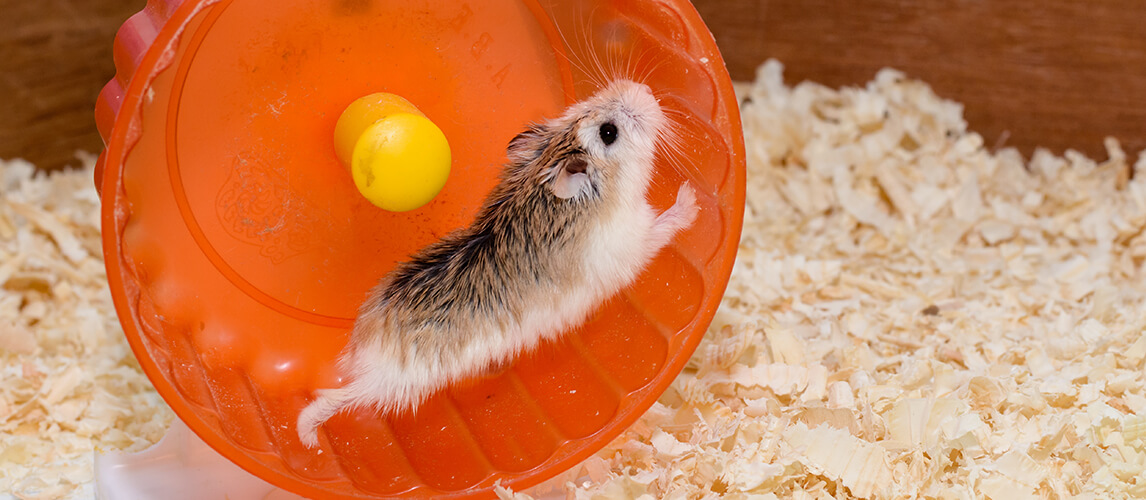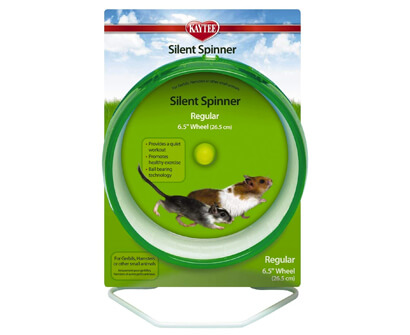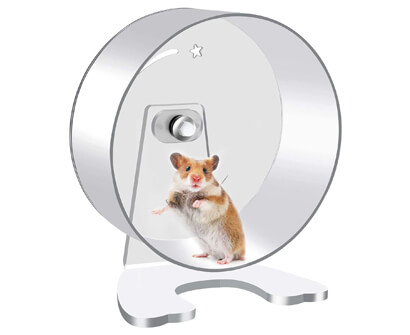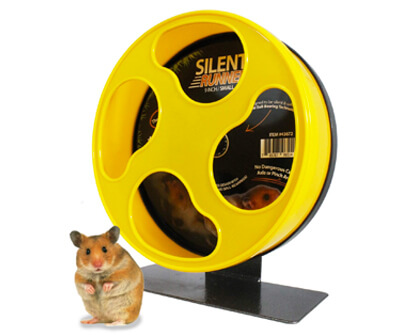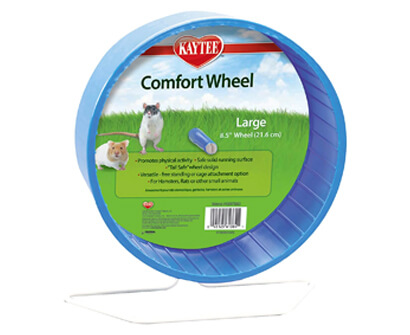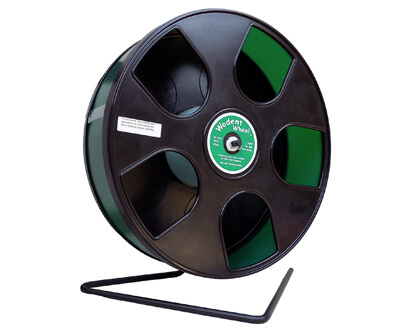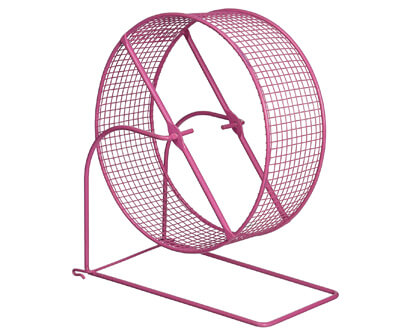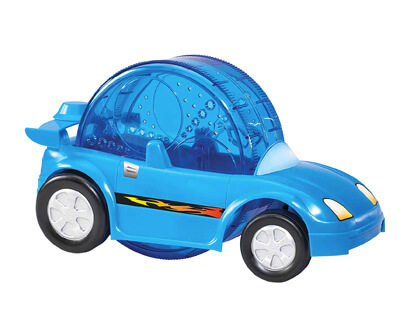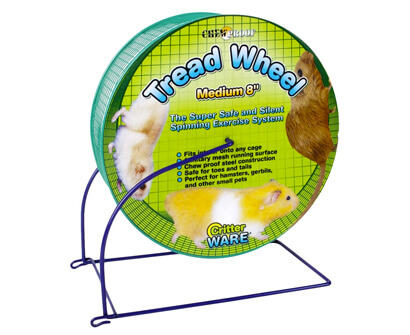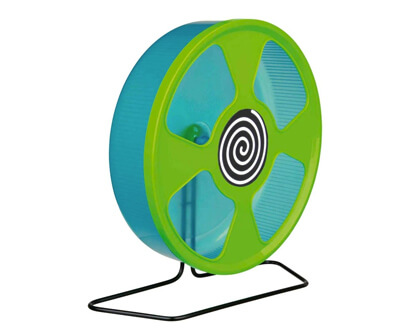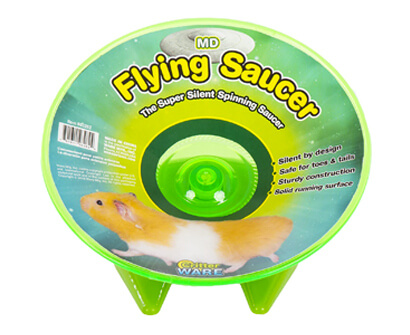- The Best Hamster Wheel
- 1. Kaytee Silent Spinner
- 2. Zacro Hamster Exercise Wheel
- 3. Silent Runner
- 4. Kaytee Comfort Wheel
- 5. Suncoast Sugar Gliders Wodent Wheel
- 6. Prevue Pet Products Hamster Wheel Toy
- 7. Kaytee Critter Cruiser Small Animal Toy
- 8. Critter Ware Treat Wheel
- 9. Trixie Exercise Wheel
- 10. Critter Ware Flying Saucer
Hamsters are some of the best pets for families and those with busy lives. They remain one of the top pet choices in the U.S. – and for good reason. Little hamsters are friendly, don’t take up much space but provide excellent company, and are fascinating to watch. The best part is they are easy to keep while you go about your day-to-day business. These curious creatures need ample exercise and what better way to provide this than through the best hamster wheels on the market today? Read on to discover everything there is to know about hamster wheels. They can make the difference in your hamster’s happiness!
The Best Hamster Wheel
1. Kaytee Silent Spinner
With an impressively quiet rotation, the Kaytee Hamster Wheel is arguably one of the best hamster wheels on the market. For good reason, too! This silent spinner is named for its key feature. It is an exceptionally quiet wheel and makes for a good night’s sleep for hamster owners. Its silent, runner wheel can be attached to the cage or used as a standalone product. It uses a solid surface for a safer run.
2. Zacro Hamster Exercise Wheel
Another quiet option that gives an added layer of style to your hamster cage is this clear exercise wheel by Zacro. This hamster wheel can be attached to a wire cage without issue or used as a freestanding exercise wheel. It provides a solid running surface, and is the ideal size for larger rodents. This product works for Syrian hamsters, too! The wheel itself remains safe against snags and gaps.
3. Silent Runner
A great and safe choice is the Silent Runner Exercise Wheel. This wheel keeps your hamster safe as they run along its solid surface. Your hamster will have a reduced risk of falling out of their wheel, and won’t get their paws or claws stuck. It even has a whisper-quiet option. Sitting at 9 inches, this is the ideal wheel for those with larger hamsters or other medium-sized rodents. It even comes with a non-slip running surface, to help hamsters gain purchase, and can be attached to the cage or used freestanding.
4. Kaytee Comfort Wheel
Another great option from Kaytee is the Comfort Wheel. It can be used with a cage on its own! With additional non-slip grips to help your hamster get a good grip while running, yet keeping the popular-solid running surface, this is a safe and secure wheel that customers love. It comes in a variety of colors and the covered axle ensures that any long-tailed rodents will remain completely comfortable and safe while using it.
5. Suncoast Sugar Gliders Wodent Wheel
Coming in as our Premium Pick, the Suncoast Sugar Gliders Wodent Wheel is perfect for older hamsters, who may be more likely to hurt their spine. It even comes with a whopping 12-inch diameter, making it ideal for larger hamsters. It can be combined with accessories from the brand to help keep claws trimmed while exercising. The running surface can be a little slipper without this, so it’s worth combining for added stability. This option is also attachable to your cage or freestanding. The size of your cage will need to be larger to comfortably fit the span of the wheel.
6. Prevue Pet Products Hamster Wheel Toy
Our first wire mesh running surface option is the simple but sweet wheel choice from Prevue. With no bearings and a freeholding design, this option ensures there’s no risk of your hamster getting their tail caught in the wheel. It can be hung onto their cage and can be used inside or outside of the cage itself, making this a great choice for hamster wheels.
7. Kaytee Critter Cruiser Small Animal Toy
Our final choice from Kaytee is this great little Critter Cruiser wheel. It includes a running option for hamsters that like to exercise inside and outside of their cage. Self-contained, this is a great choice for storing your hamster while you clean their cage, or simply for letting your hamsters run around the house to fulfil their exploring instinct. Lower the outer design to have this hamster wheel become freestanding, or raise it to give them a little more free will!
8. Critter Ware Treat Wheel
The Ware Manufacturing Metal Exercise Wheel is a wire mesh wheel that provides the best value for money. Although it can only be used as a freestanding wheel, it’s a great option if you want a safe, reliable choice that allows your hamster to explore what they are most interested in. This is a wheel that is extremely easy to set-up and clean, while remaining chew-proof and fast-moving.
9. Trixie Exercise Wheel
A cute, bright option, the Trixie Exercise Wheel includes ample safety features. This exercise wheel is perfect for those seeking a very large wheel, while having it remain safe for bigger, or older, hamsters. It can be attached to the cage or used as a standalone product. This wheel has an additional level of safety with the front-facing wall to stop your pet from accidently slipping and falling out during use.
10. Critter Ware Flying Saucer
Our only saucer option comes from Ware Manufacturing Exercise Wheel for Small Pets and has proven to be very popular with customers. Ideal for smaller rodents, including dwarf hamsters, this is a sturdy design that allows your hamster to pick up speed, while remaining extremely quiet. Its smaller diameter means you should be able to fit this into most cage sizes. Despite the design, this saucer wheel is extremely safe for your hamsters to use without supervision.
Hamster Wheel Buying Guide & FAQ
Why Do Hamsters Need an Exercise Wheel?
Regardless of size, all hamsters and small animals need exercise. In the wild, hamsters naturally run for miles as they explore and discover. This helps them build up a massive tolerance to physical exertion. Despite being domesticated, hamsters still have those extremely high physical thresholds and can quickly become bored or even ill, if those needs are not met.

Things to Consider When Buying a Hamster Wheel
It may seem that buying a hamster wheel is a pretty straightforward process. However, there are a number of things to consider and ensure you’re buying the best hamster wheels for you and your furry friend's needs.
Safety and Design
There’s a couple of different factors to consider here, including how stable and secure your hamster’s wheel is. Cheaper models are more likely to be less secure, and run the risk of coming loose from a cage or toppling over during use. So it's important to know of their stability in advance!
At the same time, having a non-slip running surface can help provide traction for your pet and stop them from slipping or struggling during use. Finally, if you’re seeking to use your wheels for an animal other than a hamster, you should also be aware of wheels which may trap tails or the fur of long-haired rodents.
Space
Your hamster’s new wheel will need to be placed somewhere that won’t prevent it from turning easily. This means you’ll need plenty of space around the wheels themselves. That being said, it’s also important to consider the size of the cage you have and the breed of hamster you adopt or buy. The most common breed is the Syrian hamster, which can grow to around six inches. Meanwhile, dwarf hamsters – being much smaller – will be better suited to smaller wheels that suit their appropriate curvature. If you want to know more about getting the best size wheel for your hamster, check out our FAQs section below.
Material and Surface
Many modern wheels come in a wide range of different materials, each with their own benefits. Plastic options are the most common and are generally much safer for your hamster to use. These usually come with a solid surface, as opposed to wire meshing. Meanwhile, metal options tend to be most frequently used for wire mesh wheels, and will often be much cheaper than their plastic opponents. They do, however, come with the risk of smaller paws getting caught between the gaps. If your hamster's little toes get caught, it could cause a fracture and a trip to the vet. These types of wheels are therefore only suitable for larger rodents.
Sound
Easily one of the biggest pet peeves for any home with a hamster is their nocturnal noise – especially when it comes to spinning hamster wheels. For your hamster, in-wheel time equals party time, which often means no sleep for owners! However, the now-common and silent hamster wheel is growing increasingly affordable. Additionally, these hamster wheels are a great choice for you and your family pet!
Different Types Of Hamster Exercise Wheels
While all hamster wheels have the same, basic premise of encouraging your hamster to run off some of their excess energy, there are different designs and styles to choose from. If you buy both, you might also find that some hamsters will automatically prefer one over the other!
The Flying Saucer
An increasingly common option for the family hamster is the flying saucer "wheel". It is an open, disc-shaped wheel that is placed perpendicular to the floor, with an angle to encourage the typical spinning motion. These wheels look great and are less likely to fall over, or have any nooks and crannies that your pet may accidentally stick their paws into. They do take up a lot of space, which can be awkward for hamsters with a smaller cage.
The Traditional Wheel
When you think of a hamster wheel, the traditional wheel is most likely the image that pops into your mind. That’s because this hamster wheel has been around for almost as long as we’ve been keeping hamsters as pets! It's the best way to help your furry friend burn off their zoomies. This also helps them stay fit. Traditional wheels are often used as standalone products or attached to a wire cage. They take up much less room than their flat counterparts.
Our Top Pick
Hamster owners can’t go wrong with this silent hamster wheel from Kaytee. One of the most popular choices on the market and loved by customers, this wheel can be attached to a wire cage or used as freestanding. It has a solid running surface, so there’s less chance that your pet’s paws will get stuck between gaps. It provides plenty of rotation without excessive effort on your hamster’s part. Best of all, it’s extremely quiet, meaning no more late-night wake-ups for you! Your nocturnal pet can keep on spinning late without disturbing everyone in the house.

Hamster Wheel FAQ
Q: Are hamster wheels noisy?
It’s no secret that some hamster wheels can be extremely noise, particularly those with an older design. The wheel workings cause a rattling sound during the night, when your hamster is awake and active, and you're trying to sleep. These days, however, hamster owners will be pleased to know that it’s more likely to find a quiet hamster wheel for your nocturnal pet. Better still, many modern designs have incorporated a “whisper quiet” factor that makes sleeping much easier, while still allowing for your hamster to get up and do their nightly marathon.
Q: What size wheel should I get for my hamster?
The right size wheel for your hamster depends entirely on the size of your hamster, and less on the space they have in their cage. This is because a wheel that is too big will take too much effort for your small hamster to move, while hamster wheels that are too small for your hamster can have a major impact on their back. As a guide, dwarf hamsters will often need a wheel diameter of around 6 inches. On the other hand, Syrian hamsters are more likely to need larger options, ranging from 8 -12 inches, depending on their sex and size.
Q: How do you make hamsters run in their exercise wheels?
First and foremost, it’s important to know that your hamster won’t use wheels that are not comfortable for them. Therefore, getting the right wheel for your hamster is only half the battle. Your hamster must understand how to run on their exercise wheel. That being said, most hamsters have an inquisitive nature and high exercise needs that will naturally encourage them to use their wheels. If your hamster isn’t using their wheel, it might be worth checking out other brands, or even trying different types of wheels, until they gain more interest.
Q: How often should my hamster use their wheel?
Again, this mainly depends on the size and breed of your hamster. The American Society for the Prevention of Cruelty to Animals (ASPCA) have noted that the average level of exercise for hamsters is around 6 miles per night. That’s a lot of running! If you notice your hamster isn’t using their wheels or saucers for longer than a day, it’s worth checking them out to make sure everything is okay.
The only exception to this is with pregnant and nursing mothers, who shouldn’t use their wheels at all. If a pregnant or nursing hamster uses her wheel, she may lose interest in her young. It can also mean her young ones are trying to use the wheel before they are ready and cause harm to themselves or each other. So make sure to watch out for that!

